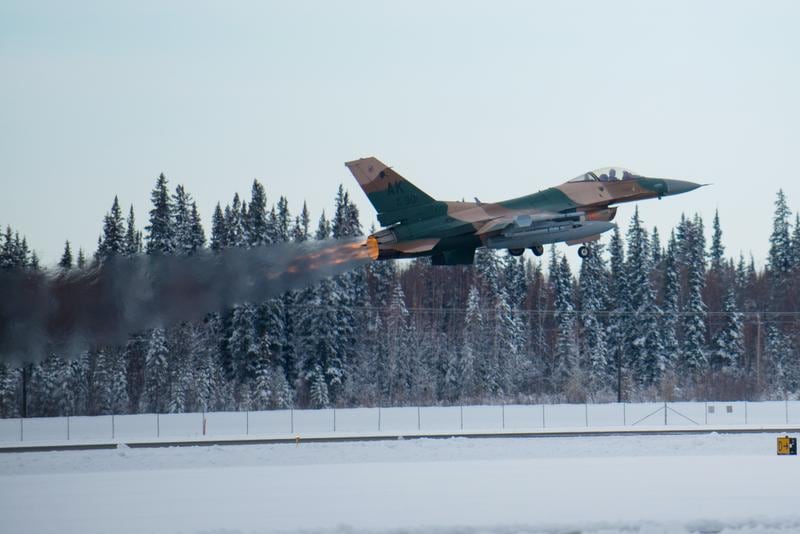And that's fine for plenty of plinkers, but for anyone that wants maximum accuracy, reduced recoil, reduced muzzle lift and decreased blast signature (pretty much everyone behind a gun) then you want to address the muzzle of your rifle. This is done by controlling the venting of superheated gasses used to create the pressure that drives the bullet down the barrel.
The most basic way to ensure accuracy is to properly crown the muzzle. This means the internal edge of the bore is machined so gasses pushing the bullet out are released uniformly. Uneven venting of barrel gasses can impart yaw on a bullet as it leaves the barrel. It also means making sure there are no edges a bullet can catch or drag on as it leaves the barrel. Most manufacturers clean up their barrel ends, though full-on crowning is more of a boutique service for long range rifles used for slow fire.
Most rifles, and tactical weapons in particular, will benefit from a brake. Also know as a compensator, a brake is a compensator that primarily tames the rearward motion of the gun, a.k.a. recoil. Though some people may argue this point strenuously, the terms "brake" and "comp" have become practically interchangeable. Plenty of muzzle devices do both, so the distinction has been lost to marketing jargon in practical terms.
moreThe majority of brakes are made using baffles or ports, or a combination of the two. Baffles are large surfaces with an aperture sized to let the bullet pass through, but limit the amount of gases that can follow it. Ports are holes drilled into, but not through the bore that redirect the expanding muzzle gasses and use them to produce directed thrust.
The upside, a brake can make your rifle more comfortable to shoot and allow you to keep your muzzle aimed at your target during multiple shots. The downside; brakes direct significant sound and concussion to the sides of the rifle, which can be distracting to a teammate, and they aren't effective at hiding the flash from a muzzle. This isn't a big deal for hunters and plinkers, but anyone that wants to conceal their position will have to weigh the speed and accuracy benefits of a brake against the signature reduction benefits of a flash hider.
Flash hiders are designed to do the opposite of a brake. Instead of concentrating and redirecting muzzle gasses, flash hiders disperse those gasses, and any unburnt gunpowder. Without getting into too much detail, muzzle flash occurs when superheated and fast moving gasses from the gunpowder explosion travel down the barrel and hit the low-pressure, oxygen-rich atmosphere past the muzzle. These gasses contain trace amounts of burning and unburnt powder that will ignite and produce a flash as the gasses and atmosphere collide. The hider spreads these gasses to slow and cool them before friction and pressure cause them to burn. The most efficient hider designs use open tines to spread the gasses in a vortex as they leave the muzzle.
Elimination of muzzle flash during nighttime operations helps in two ways. First, it helps conceal the location of the shooter from enemy forces. Second, muzzle flash can interfere with shooter's nighttime adapted vision and cause momentary whiteout (or greenout) of NVGs.
Here are some factors to consider when choosing a muzzle device for your rifle:
Barrel length- A standard 16" rifle barrel in 5.56 NATO/.223 caliber produces about 7000 psi of pressure at the muzzle, while a 10" barrel can pile on twice that. The high concentrated and superheated gasses on shorter barrels strain the design and materials of flash hiders. Look for a flash hider or brake designed to deal with the abuse of a short barrel if you're going less than 14.5".
Suppressor compatibility- All suppressor fast-attachment systems are proprietary. If you run a can, you'll be limited in your selection of muzzle devices to those compatible with the attachment method of your suppressor. Muzzle devices designed to work with suppressors, either brakes or flash hiders, will usually have the word "adapter" someplace in their name or description.
Durability- almost all muzzle devices will outlive a barrel provided they can withstand the riggors of daily use. Thanks to advances in metallurgy, modern open tine hiders are stronger than the original A1 that broke and led to the Army's adoption of the stronger, A2 birdcage style hider. In compensators, look at beefy connections between baffles that won't get crushed in a muzzle strike.
Possibility for bore obstruction- Getting vegetation stuck in the tines of an open flash hider may be a problem in some dense jungle battlefield. It's pretty rare, and only worth mentioning because it was a popular but largely pointless, arm-chair warrior's argument against the open tine design in the past.
Installation- Unless you're running a sound suppressor, flash hiders are untimed and can be installed using a simple crush washer. Torque specs are not as critical with a crush washer so you can get away without needing a torque wrench. But, brakes and some sound suppressor adapters are installed using shims so that the ports and/or sound suppressor mounting index pins face the right direction. These are timed, carefully torqued and held in place with rockset, or some high-temperature thread locking compound. You'll need a torque wrench if you want to have confidence you've installed your brake correctly.
Size and Weight- I'm normally a stickler for weight, but here's an area of your rifle where weight isn't a big consideration since the spread in device weights covers only a few ounces. Size isn't a big consideration since the devices size is pretty much based on the caliber of the host weapon. One caveat; the length of a muzzle devices can be used when determining the overall length of a barrel in determining compliance with ATF short barrel rifle regulations. Welded in place, a long muzzle device can bring a 14.5" barrel length up to 16" and prevent the need for paperwork and a tax stamp.
Thread pitch and caliber- Muzzle devices are generally sized two ways, caliber and thread pitch. In addition, some rifles have non-standard barrel-end profiles and require a device with a specific length and inner profile. You'll have no trouble finding 1/2"-28 threaded devices for an AR/M16/M4, While 5/8"-24 threads are common on .308 caliber barrels. If your barrel isn't threaded, a gunsmith or machine shop can likely thread your barrel for under $100.
Cost- An A2 birdcage style flash hider can be had for less then $10, while a highly optimized brake can push $165. Plan on dropping around $100 or more for a quality device.
FLASH HIDERS:
A2 Style Birdcage
The original flash hider on the M16 was an open-pronged design. The problem with it wasn't performance, but durability. 1960s metalurgy couldn't produce a strong enough steel to hold up when shaped into open prongs. Broken prongs became an issue and was eventually solved with the closed-end design of the A2 "birdcage" flash hider. Interestingly, the closed bottom of the A2 is sometimes mistaken for a compensating mechanism when it's really just there to reduce dust and debris kick-up. It's fairly effective at dissipating gases, but most of the gas and unburned fuel end up coming straight out with some flowing through the slotted ports. There's enough turbulence to slow things down, but not enough to completely eliminate flash in faster moving gasses as found on shorter barrels. The A2 remains a popular design because it's small, inexpensive and works reasonably well on longer barrels. $10, available everywhere.
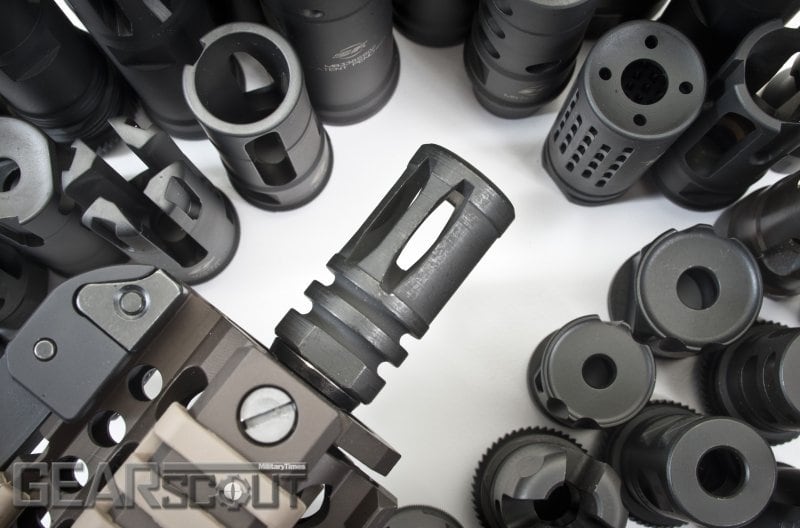
B.E. Meyers
With night vision technology coming of age and its wide deployment during the Global War on Terror, some parts of the DoD began looking for a way to minimize muzzle flash's effect on NVGs. In 2002, Brad Meyer's company B.E. Meyers was producing night vision equipment and noticed that there was a problem with image blooming when firing weapons using night vision systems. "We tried several flash hiders that were available at the time, but in 2002 there were just no adequate flash hiders available on the market," he told me.
He addressed the problem with a scientific approach and learned to employ two key, and now patented features to reduce muzzle flash; offset, asymmetrical and non-parallel tine design and the use of expansion grooves on the inside of the tines.
Both of these features can be seen when looking down the muzzle of their 5.56mm and 7.62mm devices. The four tines in a BE Meyers flash hider form an offset cross that the hot gasses expand around. The interior of the tines are serrated and cause more turbulence as the gasses flow around the tines. A third design feature is the resonant frequency of the tines as the bullet passes through the device. The length, width and material all play a part in determining how the tines expand and contract, thus forming another level of disruption acting to slow and disperse the hot gasses. Their .50 caliber flash hider has no expansion grooves, but it does have a patented, method of tool-less installation that needs nothing more than an initial hand tightening since it tightens itself as the weapon is fired.
B.E. Meyers flash hiders have been limited to military and law enforcement customers up until this week. The 7.62 NATO and .50 cal. hiders are not yet for sale to the public, but they've announced that the 249F 5.56 NATO flash hider is now available exclusively on the civilian market from Weapon Outfitters where they cost $124.95. [nggallery id=602]
[nggallery id=602]
Noveske KX3
Designed for short barrel rifles exclusively, 10.5" and shorter, the patented design is based on the Bulgarian AK-74 SU Krinkov 4-piece flash hider.
Originally the KX3 was designed to help cycle the shorter, finicky gas systems of SBR by increasing the gas system dwell time. But the need for that benefit has been reduced thanks to better understanding and updated gas system designs in found recent carbines. The main benefit now is how the device eliminates flash and directs all concussive force downrange. This reduces the startle reflex and enhances the situational awareness of teammates when operating in close quarters.
The device works differently than the birdcage and open prong design. It uses a cone shaped baffle that syphons expanding gasses into an enclosed expansion chamber where they can cool before mixing with the outside air as they find their way out once the bullet leaves the secondary bore. $130 www.noveskerifleworks.com.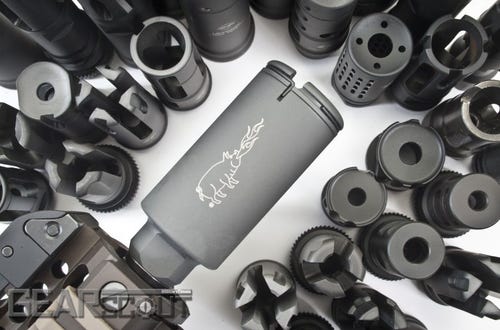 [nggallery id=606]
[nggallery id=606]
AAC Blackout
The AAC Blackout flash hider is nearly as effective as the B.E. Meyers, but is 40% shorter. It uses a thick, three tine design with scalloped bases to begin the formation of a vortex as soon as the gasses enter the expansion chamber of the hider. This design, and the B.E. Meyers, were both highly rated and purchased by the U.S. Army for use as a signature reduction device by soldiers in Afghanistan. In 2010, the Joint Special Operations Command performed its own tests in support of a contract to outfit its operators with effective flash suppression. They found the AAC Blackout and B.E. Meyers flash hiders were both 96% more effective in reducing muzzle flash than an A2 birdcage hider. $100, www.advanced-armament.com.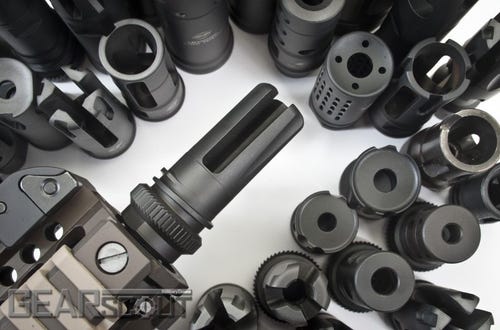 [nggallery id=599]
[nggallery id=599]
DS Arms M4/AR15 FAL Belgian Style Flash hider
Tough and angry, DS Arms is turning out a toothy FAL flash hider for use on a standard 1/2-inch/28 threaded AR barrel. Made of 8620 steel, it ís even compatible with FAL bayonets. It's an option for guys who want something different from the stock AR look. $25, www.dsarms.com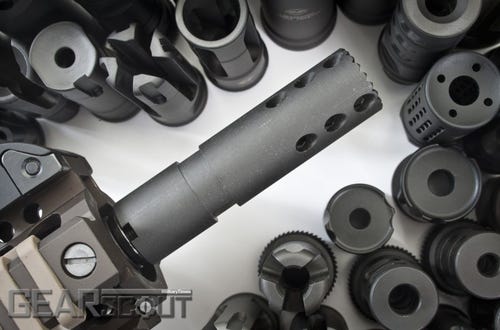 [nggallery id=605]
[nggallery id=605]
BRAKES:
Surefire MB762KN-SR25
Surefire muzzle brakes are regarded as immensely effective at controlling muzzle rise and recoil. They redirect gasses using a combination of large open baffles that control recoil and smaller ports that address muzzle rise. Surefire's refinement of the traditional baffle design has a side effect; lateral concussion. The forces are directed evenly to the sides and rear, but so is sound and pressure making the brake wonderful to shoot, but unpleasant to stand next to.
New this year are neutral brakes that are designed to apply downward pressure from the 12 o'clock position, perfect for shooting from a supported position, like a bipod. Surefire calls this feature "neutral porting". This is different than the standard brakes that are ported at the 2 o'clock position to keep an unsupported shooter on target. The new neutral brakes have pilot holes on each side of the device that can be opened up by the end user to correct right or left hand bias found in some weapons. Starting with a tiny drill bit, bore through and send a few rounds downrange to see how it feels. If you need a little more adjustment, just open up the port a little more with a larger bit. Look for an "N" in the model number of their brakes to get this option. The new neutral brakes are $149 retail and are available for the 6.8 and 7.62 and .300 Win Mag. $150 Surefire.com.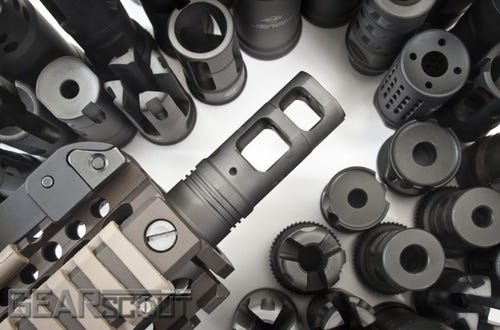 [nggallery id=604]
[nggallery id=604]
Battlecomp 2.0
Developed using computational fluid dynamic modeling software, the BattleComp went from idea to product in just seven weeks. Then in less than a year, it's became one of the most popular muzzle devices on the AR market. The scientific approach was to use modeling to get 85% efficiency in all aspects of gas control. And it seems they nailed it. Instead of using large, open baffles Battlecomp uses a matrix of small ports around the circumference and end of the device. Things like the location, shape, diameter and distribution of the ports, and the chamber size of the device all play a part in determining the performance of the BattleComp. The device gets the nod for its compact size, and ability to keep recoil and muzzle flip down while not punishing adjacent shooters with sound and concussive force. There are three flavors of BattleComp devices for .223 caliber, the 1.0 which is the original design, and the 2.0 which is a refinement of the 1.0 that is designed to be compatible with a few sound suppressors. The 1.5 is simply a longer 1.0 that is designed to be pinned and welded in place to bring a 14" barrel up to 16". The BABC (Big Ass BattleComp!) is the a 1.0 for .308 caliber rifles. $150-$220 www.battlecomp.com.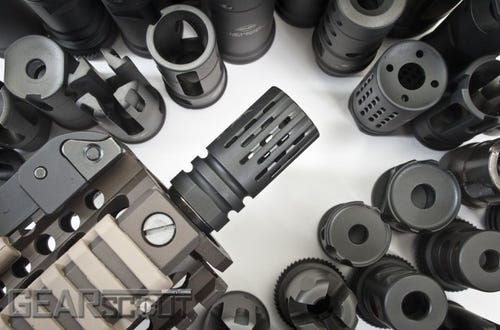 [nggallery id=601]
[nggallery id=601]
AAC BrakeOut
Brakes reduce flash but not nearly as effectively as a dedicated flash hider. By dropping one baffle and replacing it with the three open tines found on the Blackout, the Brakeout gives up about 10% of it's braking performance but adds a capable flash hider. It's a worthy compromise for shooters that require some flash reduction along with braking, say in a short barrel rifle application. The flash hiding capability is a on par or a bit better than an A2 flash hider in our informal testing. Just realize the BrakeOut is a compromise. It's far more effective as a brake than a flash hider. If you need muzzle control and flash reduction together, the BrakeOut is your ticket. $100 www.advanced-armament.com.
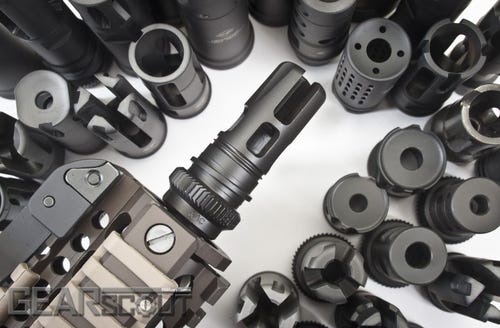 [nggallery id=600]
[nggallery id=600]
Ares Armor Effin-A
The Effin-A brakes feature DIY porting. Available for AR15 (5.56), AR10 (.308) and AK-47s, the devices come with all ports open so you can shoot a group while feeling how your muzzle moves. Then, plug the ports with the included threaded inserts until youíve tuned out all the muzzle rise and shift. Ares says this can be done on the range in as little as three strings of shots.
$99, www.aresarmor.com [nggallery id=607]
[nggallery id=607]
